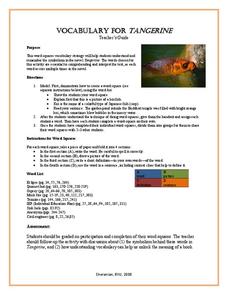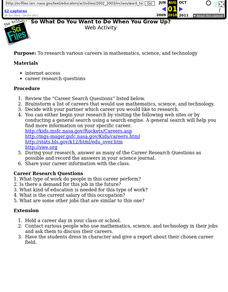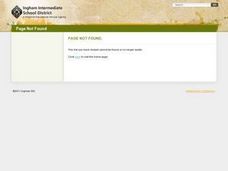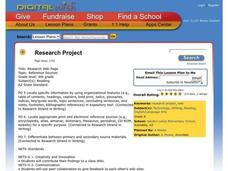Bermingham City Schools
Opinion Writing
It's no secret that children can be very opinionated, but rather than fight against this natural tendency, embrace it with this primary grade writing project. After a shared reading of a children's book about...
Visa
Smooth Sailing: Exploring Insurance and Estate Planning
While purchasing insurance and estate planning may seem like a rather irrelevant topic for high school young scholars, introducing this concept now can help your learners develop a solid foundation of financial literacy that...
Novelinks
Running Out of Time: Anticipation Guide
Get your class ready to read with this anticipatory set for Running Out of Time. Small groups each consider one thought-provoking statement. After each group comes to a consensus, the whole class participates in sharing ideas and voting...
Curated OER
Tangerine: Vocabulary
Here's a great way to make vocabulary words drawn from Edward Bloor's novel Tangerine memorable. Kids create a word square, and in one quadrant write the word. A picture goes in a second quadrant, the definition in a third, and a...
NASA
Catch a Piece of the Sun
What does the sun mean to you? Learners have many different interests that may have connections to the sun. Whether its solar radiation, solar flares, or solar storms, there are connections to daily interests that may surprise your...
American Museum of Natural History
Make Your Own Earth Stationary
Scholars follow five steps to make personalized Earth-themed stationary. Personalization includes name and returns address.
ReadWriteThink
Dear Librarian: Writing a Persuasive Letter
Everyone deserves to read a great book! Here, pupils write a persuasive letter to the school's librarian detailing their favorite story and why it should be found on the shelves. Class members' persuasive reading passages are shared with...
Curated OER
Testing Foods
Students perform an experiment using brown paper bags to determine which foods have oil in them. This task assesses student's abilities to make simple observations and inferences from them.
Curated OER
Use of Numbers
In this number usage learning exercise, students tell how each number is being used in the given examples. Students write position, count, measure, and label for the number uses. Students also complete two test prep questions about uses...
Curated OER
Measurement: Length, volume, and temperature
Learners determine the temperature of the water in a cup, measure the length of a piece of cardboard, and measure out an appropriate volume of water. This task assesses student's abilities to perform measurement and reporting skills.
Curated OER
So What Do You Want to Do When You Grow Up
Students research the responsibilities, required education, remuneration and demand for different of varied careers in math, science and technology. They access websites which are imbedded in this plan in order to do their research.
Curated OER
Choose the correct word
In this hot or cold worksheet, 2nd graders look at the picture and identify if it is showing something hot or cold. Students complete 1 problem.
Curated OER
Finding the Flu
Students work to determine when the flu is most prevalent in the United States. They gather data on their own, create calendar, charts, and graphs, analyze their findings and present them. This is a very appropriate winter lesson!
Curated OER
Count and Add Tables
In this number sentence worksheet, students complete a number sentence about adding tables together. Students complete 1 number sentence.
Curated OER
Alternative Energy
Students discover the different alternative fuel sources. In this biology lesson plan, students identify the different stages of the carbon cycle. They explain the pros and cons of using alternative energy.
Curated OER
ReQuest and Motor Imaging with My Side of the Mountain
Fifth graders read "My Side of the Mountain." They create a pantomime using vocabulary words from the story. Students create three questions about the reading. They discuss the passage they read and act out words to help them better...
Curated OER
Ida Tarbell: Hysterical Woman vs. Historical Facts
Young scholars examine journalism and its different styles. In this effective communication instructional activity students create an editorial message and articulate an article.
Curated OER
Poetry for Kids
Sixth graders be immersed indirect experiences which are opportunities for students to reflect, look back, debrief or abstract from their experiences what they have felt, and thought, and studied.
Curated OER
Research Project
Eighth graders research a project of their choice in relation to a career they may want. In this language arts instructional activity, 8th graders create a bibliography of references used both print and online sources. Students make an...
Curated OER
Reading Lessons for Alaska State Standards - Reading Rate and Fluency
Sixth graders read a given passage silently. The student then reads the same passage orally to a partner. The partner records the number of words pronounced incorrectly. The student then sets goals to increase oral reading speed and...
Curated OER
Chocolate Chaos
Second graders demonstrate the ability to examine the elements of a story (theme, plot, setting, mood) and characters, by discussing and writing about each. They have fun with chocolate related activities and enjoy reading about some...
Curated OER
A Little Mystery and Intrigue in Writing Short Detective Stories
Learners read and analyze the twelve short stories in the novel "The Adventures of Sherlock Holmes." They create their own detective that has to solve a new kind of crime, and write and edit a short story with their original detective as...
Curated OER
PowerPoint Presentation of Fudge Comic Strips
Fourth graders create comic strips for presentation to the class. They make drawings, record them digitally, transfer them to a KidPix program and then arrange them in a PowerPoint presentation in a comic strip format.
Curated OER
Language Arts: Character Comparison
Fourth graders, using Kidspiration, compare and contrast the two main characters from Tales of a Fourth Grade Nothing. They use a teacher-created template to describe their characters. Students then create their own character analysis.























